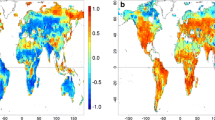Abstract.
As the use of space-based sensors to observe soil moisture is becoming more plausible, it is becoming necessary to validate the remotely sensed soil moisture retrieval algorithms. In this paper, measurements of point gauges on the ground are analyzed as a possible ground-truth source for the comparison with remotely sensed data. The design compares a sequence of measurements taken on the ground and from space. The authors review the mean square error of expected differences between the two systems by Ha and North (1994), which is applied to the Little Washita watershed using the soil moisture dynamics model developed by Entekhabi and Rodriguez-Iturbe (1994). The model parameters estimated by Yoo and Shin (1998) for the Washita `92 (relative) soil moisture data are used in this study. By considering about 20 pairs of ground- and space-based measure-ments (especially, for the same case as the Washita `92 that the space-based sensor visits the FOV once a day), the expected error was able to be reduced to approximately 10 of the standard deviation of the fluctuations of the system alone. This seems to be an acceptable level of tolerance for identifying biases in the retrieval algorithms.
Similar content being viewed by others
Author information
Authors and Affiliations
Rights and permissions
About this article
Cite this article
Yoo, C. A ground validation problem of remotely sensed soil moisture data. Stochastic Environmental Research and Risk Assessment 16, 175–187 (2002). https://doi.org/10.1007/s00477-002-0092-6
Issue Date:
DOI: https://doi.org/10.1007/s00477-002-0092-6




